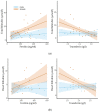Bilirubin Levels in Infancy and Their Associations with Body Weight, Levels of Iron-Related Parameters and Steroid Hormone Levels
- PMID: 39057716
- PMCID: PMC11279372
- DOI: 10.3390/metabo14070393
Bilirubin Levels in Infancy and Their Associations with Body Weight, Levels of Iron-Related Parameters and Steroid Hormone Levels
Abstract
It is assumed that bilirubin is hormonally regulated and influences weight development by preventing weight gain. However, studies in healthy infants are limited. The present study established reference values for bilirubin and investigated whether bilirubin levels are significantly associated with body weight, levels of ferritin and transferrin as well as steroid hormone levels in a study population of three- and six-month-old healthy infants. Data from a total of 411 study visits from the LIFE Child study (Leipzig, Germany) were analyzed. Associations were examined using linear regression analyses. Besides laboratory parameters, anthropometric data were gathered. We found statistically significant associations between body weight and bilirubin levels. In girls, we observed additional associations between bilirubin levels and both ferritin and transferrin concentrations at three months of age. At six months, steroid hormone levels were significantly associated with concentrations of total and indirect bilirubin, with effects differing by sex. Our study thus confirms associations already reported from animal studies and studies in adult populations. Furthermore, we showed that these associations already exist in the first year of life, are influenced by sex and age and, further, depend on the bilirubin type. Our results provide reference values for bilirubin and assist, therefore, in interpreting bilirubin levels in infancy.
Keywords: bilirubin; body weight; ferritin; infancy; steroid hormones; transferrin.
Conflict of interest statement
The authors declare no conflicts of interest.
Figures





References
-
- López-Velázquez J.A., Chávez-Tapia N.C., Ponciano-Rodríguez G., Sánchez-Valle V., Caldwell S.H., Uribe M., Méndez-Sánchez N. Bilirubin Alone as a Biomarker for Short-Term Mortality in Acute-on-Chronic Liver Failure: An Important Prognostic Indicator. Ann. Hepatol. 2013;13:98–104. doi: 10.1016/S1665-2681(19)30910-X. - DOI - PubMed
Grants and funding
LinkOut - more resources
Full Text Sources

